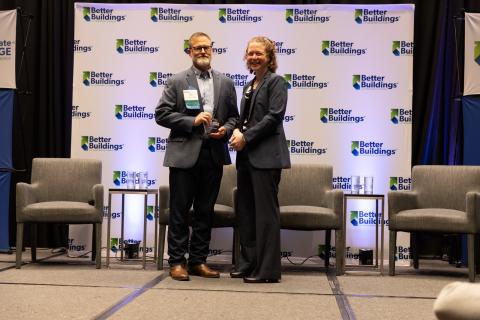UVA recently received the Better Practice Award from the US Department of Energy (DOE), recognizing the University’s industry-leading accomplishments in energy management through its Green Building Standards.
The University of Virginia has emerged as an industry leader in energy efficiency and sustainable practices once again. The University was recently awarded the Better Practice Award, presented to recognized partners of the Better Buildings Program by the U.S. Department of Energy (DOE), for its innovative and leading work implementing Green Building Standards. “As a winner of a Better Practice award, the University of Virginia has demonstrated an innovative pathway to improve energy efficiency and reduce emissions that other organizations can learn from,” said Carolyn Snyder, Deputy Assistant Secretary for Buildings and Industry at the DOE.
With a portfolio of more than 550 buildings, about 15.3 million square feet, new and existing buildings are responsible for the majority of UVA’s energy, carbon, and water footprint. When it comes to improving energy efficiency in new construction and major renovations, UVA's Office for Sustainability recognized that the early integration of sustainability into the project design was key. So the team worked to create a series of Green Building Standards to improve long-term efficiency and reduce life cycle costs in new construction and renovations.
These Green Building Standards, informed by standards such as LEED, ASHRAE, AIA, WELL, and others, have become an integral part of the University Design Guidelines and are now required for all construction projects. They outline UVA’s minimum expectations for aligning University-wide sustainability goals with building design, construction, and maintenance, while optimizing project sustainability. Each requirement has one or more of the following goals: reduce environmental impact, reduce anticipated life cycle costs, and/or promote healthier and safer buildings. These goals are achieved through equipment standards, electrification of energy systems, performance targets, and more. For example, all new buildings at UVA are required to be LEED certified and use high efficiency equipment. The improvement in energy efficiency from these requirements generates significant cost savings, particularly in the operations of the building, and allows the money saved to be reinvested elsewhere.
Achieving these standards allows the University to reduce operating costs, enhance occupant health, and improve building resiliency. They also garner University awards. In 2023, the University was recognized by the Department of Energy (DOE) for its 27% reduction in energy intensity over the past 10 years as a part of their Better Buildings Challenge. This voluntary program encourages organizations with large portfolios to pledge to reduce their energy consumption. As an active member for the past 10 years, the University was recently recognized in the DOE’s 2023 Better Buildings Initiative 2023 Progress Report as an industry leader and honored in a ceremony at the Eisenhower Executive Office Building in October.
The Better Buildings Challenge is just one example of UVA’s success. Now, the University is pursuing the Better Climate Challenge, an ambitious, portfolio-wide 50% reduction in Scope 1 & 2 greenhouse gas emissions. The Challenge is focused on reductions between 2019 and 2029. The good news: the University has already achieved a 44.6% reduction in metric tons emissions of carbon dioxide in its buildings over the past 10 years.
Being recognized on a national scale as an emerging leader in energy efficiency recognizes the hard work done by so many individuals at the University to strengthen the presence of sustainability. And the University community reaps the long-term benefits including lower utility bills, improved occupant comfort, longer building life cycles, and reduced environmental impact. As 2030 comes closer, the University is on track to rise to the climate challenge.
(Banner photo: Ethan Heil presenting on the Green Building Standards)
Ben Nilson is a 4th-year student majoring in Public Policy & Leadership and Global Sustainability, and an intern in the Office for Sustainability. Ben is interested in environmental justice and policy.



